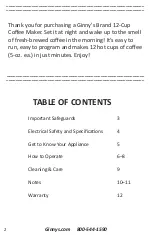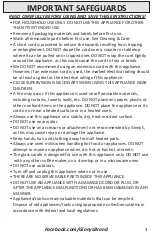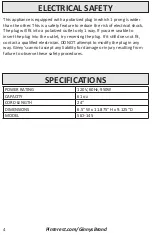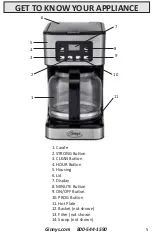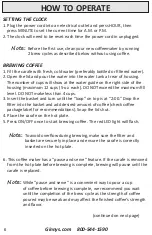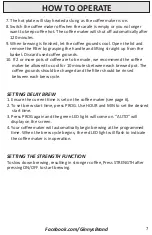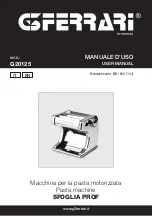
9
Ginnys.com 800-544-1590
CLEANING & CARE
DAILY CLEANING
1. Turn off and unplug the coffee maker.
2. Always allow the appliance to cool completely before cleaning.
3. Remove the basket and filter. CAUTION: there may still be some hot liquid
in with the grounds in the filter or basket. Discard the coffee grounds.
4. DO NOT use harsh or abrasive cleansers on any part of your coffeemaker.
5. Wash the carafe, filter and basket in warm, sudsy water or place in top
rack of the dishwasher.
6. Wipe the housing and hot plate with a damp cloth.
6. DO NOT try to clean the inside of the water tank with a cloth (this may
leave a residue of lint and could clog your coffee maker). Only rinse with
cold water periodically and leave the lid open to air dry.
7. DO NOT immerse any cord, plug or electrical appliance into water.
8. Ensure all parts are dried thoroughly before reassembling and using
this appliance.
DECALCIFYING THE COFFEEMAKER
1. Calcium buildup frequently occurs in drip coffeemakers. This is normal
and is caused by minerals commonly found in water. Your coffee
maker will need decalcifying when you notice an obvious slow down in
brewing time. We recommend decalcifying at least 4 times per year. When
60 pots of coffee have been brewed, the green LED light will flash. This is a
reminder to decalcify.
2. Decalcify your unit with a solution of 2 Tbsp. white vinegar in 1 carafe
of cold water.
3. Pour this solution into the water tank, close the lid and place the carafe
on the hot plate. Press CLEAN. The green led light will come on.
4. When the cleaning cycle is finished, empty the carafe and rinse it with
clean water.
5. Refill the water tank with cold water only and run a normal brew cycle
(see page 6). Repeat. This will rinse out any remaining vinegar solution.


